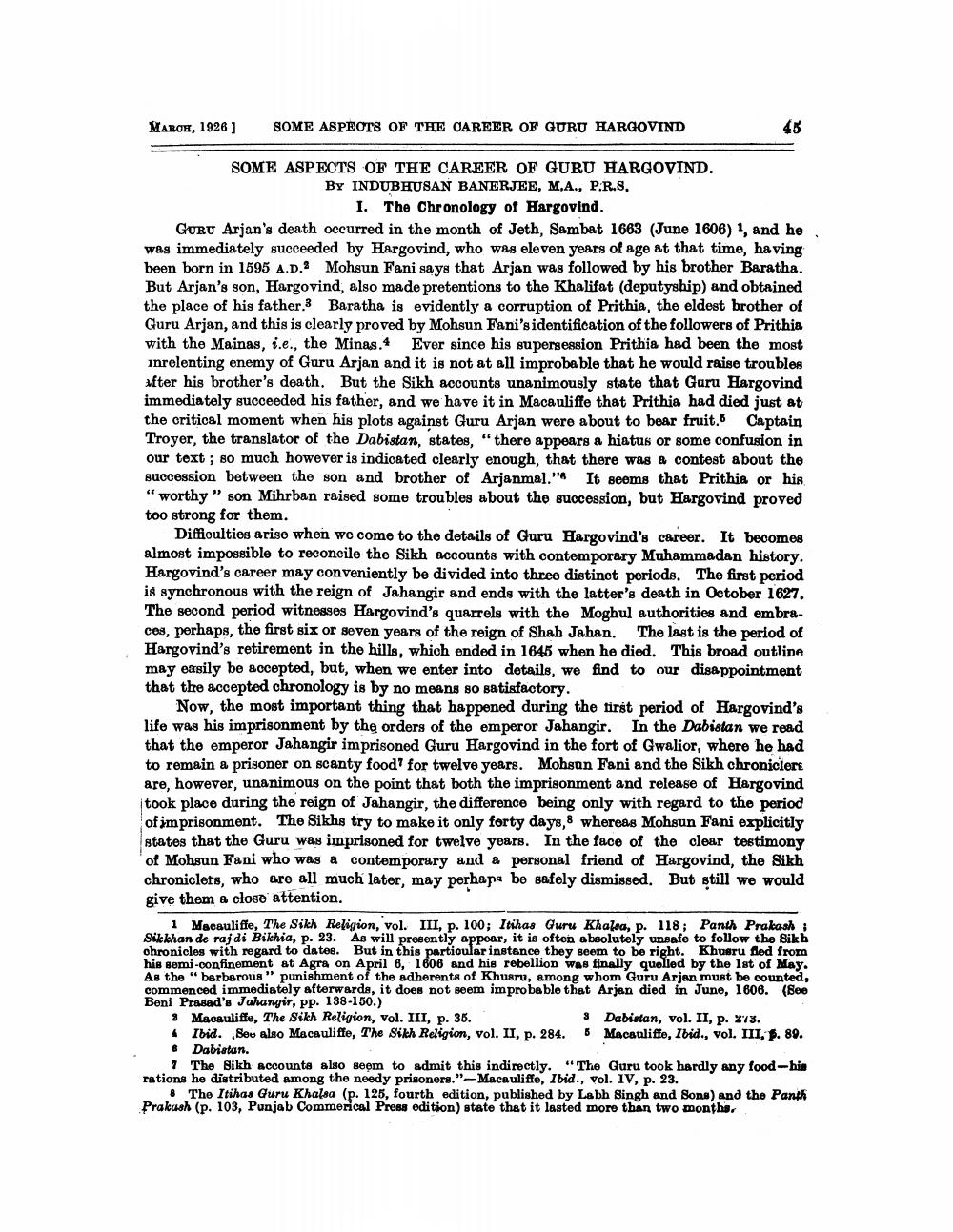________________
MAROE, 1926 ]
SOME ASPECTS OF THE CAREER OF GURU HARGOVIND
45
SOME ASPECTS OF THE CAREER OF GURU HARGOVIND.
BY INDUBHUSAN BANERJEE, M.A., P.R.S.
1. The Chronology of Hargovind. GURU Arjan's death occurred in the month of Jeth, Sambat 1663 (June 1606) !, and he was immediately succeeded by Hargovind, who was eleven years of age at that time, having been born in 1595 A.D. Mohsun Fani says that Arjan was followed by his brother Baratha. But Arjan's son, Hargovind, also made pretentions to the Khalifat (deputyship) and obtained the place of his father.3 Baratha is evidently a corruption of Prithia, the eldest brother of Guru Arjan, and this is clearly proved by Mohsun Fani's identification of the followers of Prithia with the Mainas, i.e., the Minas. Ever since his supersession Prithia had been the most inrelenting enemy of Guru Arjan and it is not at all improbable that he would raise troubles after his brother's death. But the Sikh accounts unanimously state that Guru Hargovind immediately succeeded his father, and we have it in Macauliffe that Prithia had died just at the critical moment when his plots against Guru Arjan were about to bear fruit. Captain Troyer, the translator of the Dabistan, states, “there appears a hiatus or some confusion in our text ; 80 much however is indicated clearly enough, that there was a contest about the succession between the son and brother of Arjanmal." It seems that Prithia or his "worthy " son Mihrban raised some troubles about the suocession, but Hargovind proved too strong for them.
Difficulties arise when we come to the details of Guru Hargovind's career. It becomes almost impossible to reconcile the Sikh accounts with contemporary Muhammadan history. Hargovind's career may conveniently be divided into three distinct periods. The first period is synchronous with the reign of Jahangir and ends with the latter's death in October 1627. The second period witnesses Hargovind's quarrels with the Moghul authorities and embraces, perhaps, the first six or seven years of the reign of Shah Jahan. The last is the period of Hargovind's retirement in the hills, which ended in 1645 when he died. This broad outline may easily be accepted, but, when we enter into details, we find to our disappointment that the accepted chronology is by no means so satisfactory.
Now, the most important thing that happened during the first period of Hargovind's life was his imprisonment by the orders of the emperor Jahangir. In the Dabistan we read that the emperor Jahangir imprisoned Guru Hargovind in the fort of Gwalior, where he had to remain a prisoner on scanty food for twelve years. Mohson Fani and the Sikh chroniclere are, however, unanimous on the point that both the imprisonment and release of Hargovind took place during the reign of Jahangir, the difference being only with regard to the period of imprisonment. The Sikhs try to make it only forty days, whereas Mohsun Fani explicitly states that the Guru was imprisoned for twelve years. In the face of the clear testimony of Mohsun Fani who was a contemporary and a personal friend of Hargovind, the Sikh chroniclets, who are all much later, may perhape be safely dismissed. But still we would give them a close attention.
1 Macauliffe, The Sikh Religion, vol. III, p. 100; Itihas Guru Khalaa, p. 118; Panth Prakash Sikkhan de rajdi Bikhia, p. 23. As will presently appear, it is often absolutely unsafe to follow the Sikh ohronicles with regard to date. But in this particular instance they seem to be right. Khusru fled from his semi-confinement at Agra on April 6, 1606 and his rebellion was finally quelled by the 1st of May. As the "barbarous" punishment of the adherents of Khusru, among whom Guru Arjan must be counted, commenced immediately afterwards, it does not seem improbable that Arjan died in June, 1606. (See Beni Prasad's Jahangir, pp. 138-150.) 9 Macauliffe, The Sikh Religion, vol. III, p. 36.
S Dabistan, vol. II, p. 273. 4 Ibid. Se algo Macauliffe, The Sikh Religion, vol. II, p. 284. 6 Macauliffe, Ibid., vol. III, p. 89. & Dabistan.
1 The Sikh accounta also seem to admit this indirectly. "The Guru took hardly any food-his rations he distributed among the needy prisoners."-Macauliffe, Ibid., vol. IV, p. 23.
8 The Itihas Guru Khalsa (p. 125, fourth edition, published by Labh Singh and Sons) and Prakash (p. 103, Punjab Commerical Press edition) state that it lasted more than two months.




